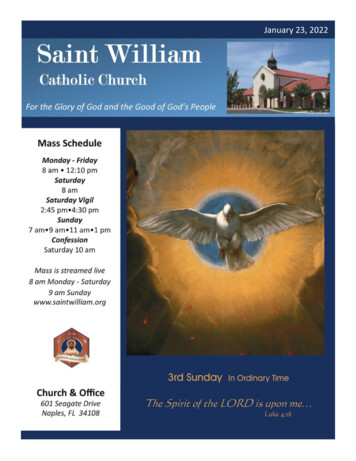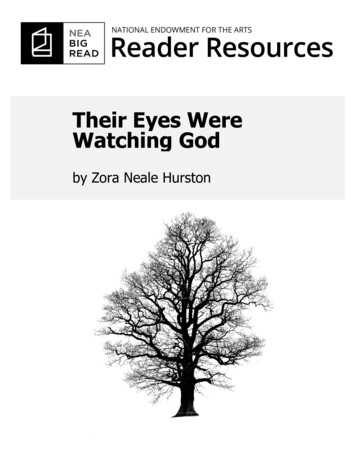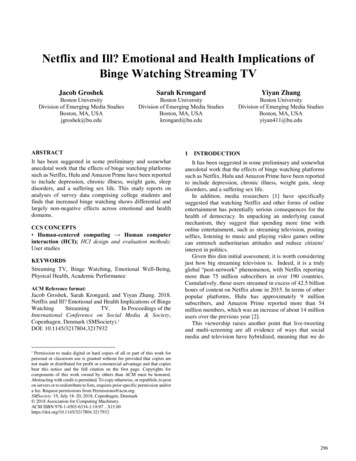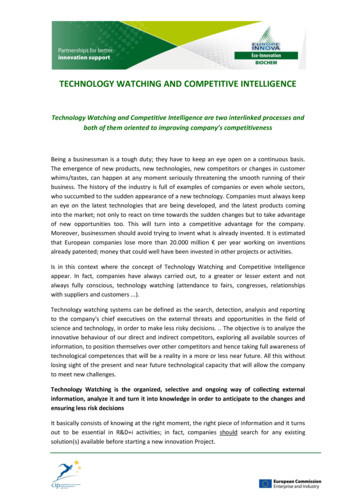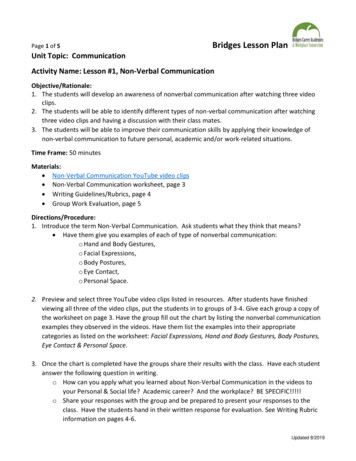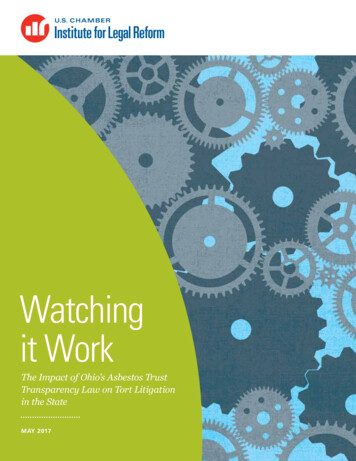
Transcription
Watchingit WorkThe Impact of Ohio’s Asbestos TrustTransparency Law on Tort Litigationin the StateMAY 2017
U.S. Chamber Institute for Legal Reform, May 2017. All rights reserved.This publication, or part thereof, may not be reproduced in any form without the written permission of the U.S. Chamber Institute for Legal Reform.Forward requests for permission to reprint to: Reprint Permission Office, U.S. Chamber Institute for Legal Reform, 1615 H Street, N.W.,Washington, D.C. 20062-2000 (202.463.5724).
Table of ContentsExecutive Summary. 1Ohio’s Historical Experience with Asbestos Litigation:A Clarion Call for Asbestos Trust Transparency. 4Case Analysis: Selection Methodology and Observations. 9In-Depth Examination of the Cases. 13Conclusion. . . 17Prepared for the U.S. Chamber Institute for Legal Reform byMaryellen K. Corbett and Matthew M. Mendoza, Calfee Hatler & Griswold LLP
Executive SummaryDuring the first part of the twentieth century, asbestos was widelyused in a variety of industrial, commercial and household products.A naturally occurring mineral valued for its flame-retardant andinsulating properties, asbestos could be found in products as diverseas pipe and boiler insulation, vinyl floor tiles, automobile brakesand cigarette filters. Many people handled asbestos on the job orat home. Unfortunately, exposure to asbestos has been linked toboth malignant and nonmalignant diseases. By the time the use ofasbestos began declining in the early 1970s, millions of individualswho had been exposed to asbestos were at risk of developing seriousdiseases. Due to the long periods, often decades, that pass betweenexposure and development of symptoms and diagnosis, the legacy ofasbestos usage and the litigation it has created are likely to exist forthe foreseeable future.The first successful asbestos-relatedpersonal injury judgment was upheld bythe federal Fifth Circuit Court of Appeals in1973.1 After that case, asbestos litigationexploded. A 2005 report by the RANDCorporation estimated that, through2002, approximately 730,000 people filedasbestos claims against at least 8,400corporate defendants.21The size and scope of the asbestos litigationhas resulted in more than 100 companiesinvolved with asbestos manufacturing andproducts filing for bankruptcy protection,with experts expecting that more willdo so.3 At least 60 of those companieshave successfully established asbestosbankruptcy trusts to resolve their futureclaims, with additional requests to establisha trust pending.4 The asbestos bankruptcytrusts have paid approximately 18billion in claims to date and have on handapproximately 37 billion for future claims.5Watching it Work
The ubiquity of asbestos in products meansthat individuals frequently were exposed toasbestos from more than one source andthus, plaintiffs often file claims with morethan one bankruptcy trust while also filingtort actions against companies that are stillsolvent. However, the asbestos bankruptcytrust system is separate from state courtsystems, which makes it more difficult forthe courts and each trust to fairly adjudicateresponsibility and apportion liability.Each trust establishes its own proceduresand processes for evaluating claims andthose procedures and processes are usuallydesigned to pay claims promptly with lowadministrative and transactional costs.6Different standards of proof also existbetween the claims that are pursued in courtand the claims pursued against the asbestosbankruptcy trusts, with the trusts typicallyhaving much lower evidentiary burdens.Many trusts also contain confidentialityprovisions mandating that a claimant’ssubmission to a respective trust and allassociated information be treated asconfidential.7 Thus, if a plaintiff does notdisclose the asbestos trust claims theyhave made, state courts and defendantsare generally not aware of all claims thata plaintiff has against other potentiallyresponsible parties, putting the defendantsat a disadvantage in the court cases.The differences in filing requirements andthe lack of transparency between the twosystems also creates a situation wherefraud and abuse can flourish. Prior totrust transparency legislation, there wasno requirement that a plaintiff file his orher trust claims concurrently with the tortU.S. Chamber Institute for Legal Reform“Thus, if a plaintiffdoes not disclose theasbestos trust claims theyhave made, state courtsand defendants aregenerally not aware of allclaims that a plaintiff hasagainst other potentiallyresponsible parties,putting the defendantsat a disadvantage inthe court cases.”action. This meant that trust claims couldbe filed after the resolution of the tortaction, preventing accurate apportionmentof responsibility in the latter. Plaintiffs couldalso create conflicting exposure narratives inthe tort action and trust claims and preventthe court from discovering this discrepancyby keeping the trust claims confidential.To alleviate these issues and to ensurefull, transparent disclosure of all sourcesof plaintiffs’ asbestos exposure from thestart of the tort action, in 2013, Ohiobecame the first state in the nation to enactlegislation to require asbestos bankruptcytrust transparency. Proponents believed thattrust transparency reform would ensure thatthe court and all parties to litigation had theinformation needed to fairly adjudicate a2
plaintiff’s claim. Those opposing asbestostrust reform argued that the delays it mightcause would prevent terminally ill plaintiffsfrom living long enough to achieve theirday in court. Now that several years havepassed since the enactment of the Ohiotrust transparency law—H.B. 380—we havethe opportunity to examine these claims.This report analyzes the impact Ohio’sasbestos trust transparency law has hadon asbestos tort litigation in the state,particularly the impact the transparencyrequirements have on the time it takes forliving mesothelioma plaintiffs’ cases to go totrial or reach resolution.8 It examines actualcases that were pending in 2010, 2012,and 2014 in the Ohio court with the mostasbestos cases. These three years werechosen because H.B. 380 became effectivein 2013, and cases from the two years prior,as well as the year after it became effective,could be examined. The report specificallyidentifies and analyzes each case in theCuyahoga County Court of Common Pleasinvolving a living mesothelioma plaintiff thatwas grouped and scheduled for trial duringeach of the three years studied (2010, 2012and 2014) to determine how long it took foreach case to be resolved and how Ohio’strust transparency law might have affectedthe process in each case.3“[T]rust transparencyreforms appear to haveaccomplished the goal ofensuring transparencyand fairness withoutimposing significantburdens on plaintiffs.”The report concludes that there isno systemic evidence that the trusttransparency reforms enacted in Ohio havecaused delays in case resolutions. Rather,when plaintiffs properly disclose theirasbestos trust claims in litigation, there isno appreciable delay in the prosecutionof cases. Further, despite opponents’concerns, it does not appear thatdefendants are using the trust transparencyprovisions to deliberately delay cases. Thisin-depth examination instead reveals thatmore often it is plaintiffs’ counsel’s trialstrategies that cause the longest delays. Inshort, trust transparency reforms appearto have accomplished the goal of ensuringtransparency and fairness without imposingsignificant burdens on plaintiffs.Watching it Work
Ohio’s Historical Experience withAsbestos Litigation: A Clarion Call forAsbestos Trust TransparencyIn the late 1990s and early 2000s, Ohio was a hotbed for asbestostort litigation, with thousands of actions filed each year in CuyahogaCounty and over 8,000 filed in 2001 alone. By 2004, more than 46,000suits were pending in the Cuyahoga County Court of Common Pleas.That year, Ohio enacted medical criteria reform legislation, whichrequired some basic threshold demonstration of an illness or injuryas a prerequisite to filing suit, thereby disallowing suits where theplaintiff claimed only exposure to asbestos with injuries that mightdevelop in the future. Ohio’s law was retroactive and applied topending claims, which allowed the court to remove more than 34,000dormant lawsuits from the docket.While Ohio courts were able to use themedical criteria laws to better manage theirdockets by focusing only on those plaintiffswith actual illness and injuries, other“concerns with asbestos tort litigation soonbecame apparent; namely, how to reconcileplaintiffs’ claims advancing in both thecourts and the asbestos bankruptcy trusts.While Ohio courts were able to use the medical criteria lawsto better manage their dockets by focusing only on those plaintiffswith actual illness and injuries, other concerns with asbestos tortlitigation soon became apparent U.S. Chamber Institute for Legal Reform”4
With these two distinct systems operatingin parallel, but generally not in tandem, itbecame obvious that there was frequentlyan information deficit between the two,leading to the possibility for misconduct onthe part of some plaintiffs’ attorneys.In 2007, Judge Harry Hanna of theCuyahoga County Court of Common Pleasbarred certain plaintiffs’ attorneys fromappearing in his court again after findingthat the attorneys had repeatedly lied to thecourt about their client’s asbestos exposurein Kananian v. Lorillard Tobacco Company.9In reviewing the multiple lawsuits andtrust claims filed on behalf of the plaintiff,Judge Hanna uncovered not only severalconflicting versions of how the plaintiffhad acquired his cancer—all tailored toextract the maximum recovery from eachdefendant and asbestos bankruptcy trust—but also instances where the attorneys hadconcealed documentation of trust claimsfrom the court.This case validated the defense bar’s longheld belief that some plaintiffs' lawyerswere practicing “double dipping”—delaying the filing of trust claims untilafter an asbestos personal injury lawsuit“This case validatedthe defense bar’s long-heldbelief that some plaintiffs’lawyers were practicing‘double dipping’ ”5is settled or goes to verdict, in order towithhold information regarding alternativeexposures from tort system defendants,thus increasing the amount they receive inrecovery from those defendants.10Ohio House Bill 380With the Kananian case still fresh in thepublic’s mind, Ohio House Bill 380 ofthe 129th General Assembly (H.B. 380)was introduced in the Ohio House ofRepresentatives on November 15, 2011.11H.B. 380’s goal was to ensure increasedtransparency and openness in the asbestoslitigation process regarding plaintiffs’ trustclaims by making the court and all involvedparties aware of the trust claims as early inthe litigation as possible. Importantly, H.B.380 did not place a cap on the amount ofcompensation that could be sought by aplaintiff, nor did it limit the number of trustswith which a claimant could file. Whereexposure and damages could be proven,according to the standards required by thecourt or the trusts, all actions and claimswere allowed. The bill was designed toensure that all legitimate claims were pursuedsimultaneously and that the court anddefendants were made aware of all of them.H.B. 380 was hotly debated in both theOhio House and Ohio Senate for more thana year, with multiple committee hearings ineach chamber. The plaintiffs’ bar vigorouslyopposed the legislation. Proponents offeredmultiple perfecting amendments, manyof which were incorporated in the bill, inorder to appease some concerns raisedby the opponents of the bill. Despite theseefforts, opponents continued to challengeWatching it Work
the bill even as it was approved by the OhioGeneral Assembly and signed by GovernorJohn Kasich in December 2012. Asidefrom a handful of Ohio-specific proceduralconcerns, the opponents’ main argumentwas that the bill could cause endless delaysand deny plaintiffs who were still alive, butat risk of dying, the opportunity to see theircases heard in court because: The bill would allow defendants to fileunlimited motions to stay the case andplaced no limit on when the motionscould be filed; and The bill would allow defendants todictate the plaintiff’s case by providinga process to require plaintiffs to filetrust claims.12Thus, opponents argued, H.B. 380 wouldessentially allow defendants to run outthe clock on very sick plaintiffs whowould die before the resolution of theircases. Proponents countered that, incases where plaintiffs' counsel providefull and appropriate disclosures, onlyminimal, if any, delays would occur.“[T]he opponents’main argument was thatthe bill could cause endlessdelays and deny plaintiffs the opportunity to see theircases heard in court Provisions of H.B. 380H.B. 380, which became effective onMarch 27, 2013, outlines the timing of thedisclosure of a plaintiff’s trust claims and theprocedures that may be employed to ensurethat all appropriate trust claims are disclosedand being pursued.The law provides as follows: Requires a plaintiff, aftercommencement of discovery in anasbestos tort action, to submit asworn statement identifying eachexisting trust claim and all supportingmaterials to the court and all parties. Timing of disclosure is tied todiscovery, as significant periodsof time can pass between filingan action and a case being set fortrial by the court, at which pointdiscovery commences. If the plaintiff or the plaintiff’sattorney later discovers newinformation giving rise to apotential claim(s) against apreviously undisclosed trust, theplaintiff must file an amendedstatement informing the court andother parties about the claim(s).”U.S. Chamber Institute for Legal Reform6
Permits a defendant to file, notless than 75 days prior to thecommencement of trial, a motion for anorder to stay the proceedings settingforth the identities of asbestos trustsnot previously disclosed where thedefendant in good faith believes that theplaintiff may make a successful claim. In response, a plaintiff may: File the trust claim(s) withthe trust(s) identified inthe defendant’s motionand upon submission ofmaterials to the court, havethe defendant’s motiondismissed or the defendantmay withdraw the motion.F ile a response to modify theinformation to be providedto the identified trust(s) orcontest that the facts in thedefendant’s motion supporta claim(s) with the trust(s)identified by the defendant.F ile a response seeking adetermination from the courtthat the cost to prepareand file the requested trustclaim(s) exceeds the plaintiff’sreasonably anticipatedrecovery from the trust(s).7 If the court determines that there isa good faith basis for filing a claimwith the trust(s) identified in thedefendant’s motion, H.B. 380 requiresthe court to stay the proceedings untilthe plaintiff files the claim(s). Where the court determines thatthe cost to file a claim exceeds thereasonably anticipated recovery, theplaintiff is not required to file theclaim but must file with the court averified statement of the plaintiff’sexposure history to the asbestosproducts covered by that trust. Generally permits the parties in theaction to introduce at trial of the tortclaim any trust claims material to provealternative causation for the claimedinjury, death, or loss, to prove a basisto allocate responsibility, and to proveissues relevant to an adjudication ofthe tort claim. If the defendant discovers the plaintifflater filed a trust claim with a trust thatwas in existence at the time a judgmentwas entered, the defendant may askthe court to reopen the judgment andadjust the award or provide other reliefas necessary for up to one year afterthe entry of the judgment.Watching it Work
Discovery, Grouping andthe Cuyahoga County LocalRules for Asbestos Tort ActionsAs noted above, one of the plaintiffs’ bar’sprincipal arguments against H.B. 380 wasthat the procedures it requires would delaycases from going to trial, thus denyingliving mesothelioma plaintiffs a resolutionto their case prior to their death. However,before understanding any impact that H.B.380 might have on delaying adjudication ofclaims, it is important to appreciate how thecourt’s local rules for asbestos tort actionsand a plaintiff’s own counsel’s conductmight affect when a case comes to trial.After an asbestos tort action is filed inCuyahoga County, the next step is forthe case to be placed into a trial group,generally referred to as “grouping” thecase. The decision on when to group a caseis completely controlled by the plaintiff’scounsel.13 The grouping of cases may occurin various ways, but all are determined byplaintiffs’ counsel. A couple of times a year,U.S. Chamber Institute for Legal Reformthe court contacts plaintiffs’ firms to inquirewhich of their currently filed cases shouldbe grouped for trial. In addition to the courtcontacting plaintiffs’ counsel, plaintiffs’counsel may, upon their own initiative, filea list of cases to be grouped with the court.In situations in which counsel has only anindividual case, he or she will contact thecourt to group the single case.In reviewing asbestos case dockets for thisreport, it became clear that while somecases are immediately grouped for trial,it is often many months or longer beforeother cases are grouped. This is crucialbecause only once a case is grouped doesthe discovery process begin and do therequirements of H.B. 380 apply. Thus, inmany cases, whether a case is resolvedprior to the plaintiff’s death has little ornothing to do with the application of theprovisions of H.B. 380, and much to dowith how the plaintiff’s counsel handles thegrouping process.8
Case Analysis: SelectionMethodology and ObservationsFollowing is an examination of the Cuyahoga County asbestosdocket in 2010, 2012 and 2014 for the impact of H.B. 380, if any,on cases grouped for trial where the plaintiff, at time of grouping,was living and had been diagnosed with mesothelioma (a “livingmesothelioma plaintiff”).The years 2010, 2012 and 2014 werechosen for study as they represent: (1) ayear in which most grouped cases shouldhave been unaffected by H.B. 380 (2010);(2) the year prior to the enactment of H.B.380 in which some cases became subjectto H.B. 380 (2012)14; and (3) the year afterenactment where all grouped cases wereclearly subject to H.B. 380 (2014).As noted above, Ohio’s medical criterialegislation greatly reduced the number ofnew asbestos tort actions filed each yearin Cuyahoga County. Even so, as Table 1illustrates, approximately 100 new caseswere filed in each of 2010, 2012 and 2014,with thousands still pending on the docketat the beginning of each year.Table 1 Cuyahoga County Court of Common Pleas Asbestos Docket159YearIncoming CasesStill Pendingat End ofPrevious YearTotal CasesAvailable tobe 675,252Watching it Work
While the total number of cases onthe docket is declining year over year,Cuyahoga County still has a very largeand active asbestos docket. Thus, fromthis larger pool, we narrowed the focusto only those cases in each year that: (1)were grouped; i.e., were at a point in theprocedural process where H.B. 380’sprocedures might have an impact; and(2) were the subject of the opponents ofthe legislation’s greatest concern—caseswith a living mesothelioma plaintiff.Table 2 Grouped Cases and Grouped CasesWith a Living Mesothelioma PlaintiffYearAll Grouped CasesLiving MesotheliomaPlaintiff Grouped Cases2010103271620122014965914171718Reviewing this carefully controlled dataset allowed for an in-depth analysis of thepotential impacts of H.B. 380 on the courseof each case.General ObservationsThe number of cases grouped each year wassmall relative to the total number of pendingcases: in each year, less than 1.5% of allcases on the docket were actually groupedfor trial. The overwhelming majority of caseson the docket are delayed because they havenot met the medical criteria requirements orhave not been selected for grouping.H.B. 380 requires a plaintiff to provide asworn statement identifying each existingtrust claim and all supporting materials to thecourt and all parties after the commencementof discovery. A defendant has a right to fileU.S. Chamber Institute for Legal Reforma motion under H.B. 380 only if the plaintiffdoes not file the required sworn statement orif a defendant believes in good faith that theplaintiff may make an additional successfultrust claim or claims. Thus, where plaintiffsfully comply with the requirements of H.B.380, any delays in the progress of the tortaction are likely due to factors not related toH.B. 380’s requirements.Under the local court rules, after cases aregrouped, the plaintiff’s counsel and defenseliaison counsel prepare a case managementorder for an eleven-month trial calendar. Itis important to understand that asbestostort actions can be very complicated cases.They involve complex medical conditionsand many parties—one case examinedin this study had 173 named defendants.Some cases may take years to conclude.However, the goal is for an asbestos tort10
“This suggests that, on the whole, H.B. 380 is not slowingthe progression of cases.”action that is grouped to take approximatelyone year from the date of grouping untilthe case is resolved.19 Thus, we examinedthe grouped cases to determine howlong it took from grouping until the casewas resolved and how the H.B. 380requirements might have impacted thatprocess.Given that the plaintiff’s counsel is largelyin control of when a case is grouped andthat the goal is for the case to take about ayear to either go to trial or settle, we reachtwo conclusions: If the plaintiff passed away less thanone year after grouping, it is unlikelythat H.B. 380 had any impact onwhether the plaintiff would have livedlong enough to see the resolution ofthe case; and If the case was resolved withinthe year time frame, then H.B.380 did not prolong the caselonger than the stated goal forconcluding an asbestos tort action.Table 3 and Chart Time From Grouping Until Death or Resolution11YearLivingMesotheliomaPlaintiffGrouped CasesLess Than1 YearMore Than1 Year20102012201427141715791278Watching it Work
Number of Cases1614Less than 1 YearMore than 1 Year1210864202010As seen in the chart above, in approximatelyhalf of the cases in each year, the plaintiffeither died or the case was resolved withinthe one-year timeframe. This suggests that,on the whole, H.B. 380 is not slowing theprogression of cases.A notable observation in reviewing casesacross all three time periods is the numberof times that a case is grouped for trial.Cases are frequently grouped many timesover the course of the case and eachtime a case is grouped anew, a new casemanagement order and trial schedule mustbe set, thus re-setting the clock. Of the27 cases examined from 2010, 18 weregrouped more than one time. One wasgrouped seven different times, first inMarch 2010 and most recently in NovemberU.S. Chamber Institute for Legal Reform201220142015, with 13 separate case managementorders. Of the 2012 cases, eight of the 14were grouped more than once, while 12 ofthe 17 cases from 2014 were grouped morethan once. Again, grouping is controlled byplaintiff’s counsel and is a key determinantof how long it will take for a case to resolve.“[G]rouping iscontrolled by plaintiff’scounsel and is a keydeterminant of how longit will take for a caseto resolve.”12
In-Depth Examination of the CasesThe 2010 CasesThe 2010 cases were examined to providea better understanding of the pre-H.B. 380timeline of an asbestos tort action. As thechart above indicates, the 2010 cases lookvery similar to the 2012 and 2014 cases interms of time to death or resolution andprovide the intended contrast.Of the 2010 cases where the plaintiff wasstill living and the case was not resolvedwithin the one-year timeframe, a few werestill on the docket in March 2013 when H.B.380 became effective. Given the length oftime that passed between grouping andthe effective date of the legislation, we didnot conduct an in-depth review of thosecases as any delay caused by H.B. 380’srequirements at that point would be minorrelative to the overall time to resolution.The 2012 CasesIn researching cases grouped in 2012, ascases can be grouped at any point in theyear, it was clear that some of the 2012cases became subject to the provisions ofH.B. 380. Thus, the 2012 cases were notan entirely accurate “before” picture ofthe docket and hence the addition of the2010 cases. However, these 2012 cases,particularly in comparison to the 2014 cases,are an interesting window into how partieswere adapting to H.B. 380.13Of the 14 living mesothelioma casesgrouped for trial in 2012: One case was resolved prior theeffective date of H.B. 380; Four cases have no H.B. 380 plaintiff’ssworn statements filed to date;20 One plaintiff filed a notice incompliance with H.B. 380; One case involved a defendant filing aletter requesting compliance with H.B.380, to which the plaintiff respondedwith a letter declaring that no asbestostrust claims had been filed; and Seven defendants filed a motion tocompel compliance with H.B. 380.“[A] closer examinationshows that plaintiff’scounsel’s trial tactics had amuch larger impact on thetiming of the case than anydelays associated with H.B.380 procedures.”Watching it Work
“[I]n each case where a motion to compel was filed, therewas only one motion to compel per case, indicating plaintiffswere likely providing full disclosures in response.In seven cases where a defendant filed amotion to compel compliance, we examinedwhether such a motion delayed or preventeda mesothelioma plaintiff who was still livingfrom seeing his or her case reach trial. Forfive of these plaintiffs, the defense motioncould not have been the cause of delay,because those plaintiffs died before thetrust transparency law went into effect inMarch 2013. Even so, in most of these caseswhere a defendant filed a motion to compel,the plaintiff responded by filing a notice ofcompliance within one-to-three weeks of thedefendant’s motion.Of the two remaining cases, while dealingwith the motions to compel certainly delayedthe progress of the case, it only did so fora short time and does not appear to haveaffected whether or not the plaintiffs wereable to have their cases heard prior to death.In each instance, the plaintiff died shortlyafter the motion was filed and counselcomplied by filing a notice. In the first case,the plaintiff died less than a year after hiscase was grouped; thus, the nine daysbetween filing and compliance had littleimpact on the delay. Of note, this case is stillnot fully resolved.While the second case involved a plaintiffthat died more than a year after the casewas grouped, a closer examination showsthat plaintiff’s counsel’s trial tactics had aU.S. Chamber Institute for Legal Reform”much larger impact on the timing of the casethan any delays associated with H.B. 380procedures. This case was originally groupedby plaintiff’s counsel on March 29, 2012. Amotion to compel was filed on May 6, 2013,and after the plaintiff’s counsel requestedtwo extensions of time to reply, the noticeof compliance was filed on May 24, 2013. Itappears the plaintiff died on June 25, 2013,more than a year after grouping. While H.B.380 motion practice delayed proceedings,the delay was minimal: It took only 19 daysto resolve the motion to compel.More importantly to this case, the plaintifffiled four amended complaints, each ofwhich added new defendants. Three of theamended complaints were filed in 2012, andthe fourth amended complaint was filed onFebruary 26, 2013, 11 months after the casewas originally grouped and just four monthsbefore the plaintiff died, each necessitatinga new case management order. There werefive case management orders filed in 2012alone and the case was regrouped twiceprior to the motion to compel (meaning thata new trial schedule was established). Thefiling of multiple amended complaints byplaintiff’s counsel, which required multipleextensions of the case schedule, waslogically a much larger contributor to thedelay in this case than the motion to compel,which took only 19 days to resolve.14
Also of note in examining the 2012 cases isthat in each case where a motion to compelwas filed, there was only one motion tocompel per case, indicating plaintiffs werelikely providing full disclosures in response.21Additionally, no motions to stay the casewere filed. The fact that there was onlyone motion to compel per case and nomotions to stay also tends to demonstratethat opponents’ fears that defendants woulduse H.B. 380’s provisions to file unlimitedmotions in order to delay the case appear tobe unfounded.The 2014 CasesThe 2012 cases represent a period inwhich both plaintiffs and defendants werebecoming aware of the new proceduresand adapting to their requirements. Unlikethe 2012 cases, the earliest of the 2014cases to be grouped were grouped in March2014, by which point H.B. 380 had been ineffect for a year and most counsel shouldhave been fully aware of the requirementto disclose bankruptcy trust claims. Aswill be described further below, the 2014cases tend to show that both plaintiffs'and defense counsel were aware of andcomplying with the requirements of H.B.380 by 2014.Of the 17 living mesothelioma casesgrouped for trial in 2014: Five cases contain no H.B. 380 plaintiff’ssworn statements filed to date; Nine plaintiffs filed a notice incompliance with H.B. 380;15 Two plaintiffs did not file a notice,b
Asbestos Trust Transparency In the late 1990s and early 2000s, Ohio was a hotbed for asbestos tort litigation, with thousands of actions filed each year in Cuyahoga County and over 8,000 filed in 2001 alone. By 2004, more than 46,000 suits were pending in the Cuyahoga County Court of Common Pleas.





